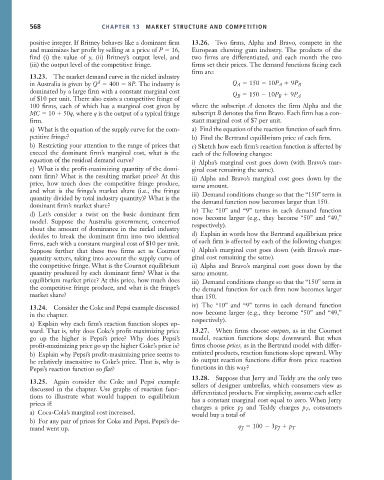Page 594 - Microeconomics, Fourth Edition
P. 594
c13marketstructureandcompetition.qxd 7/30/10 10:44 AM Page 568
568 CHAPTER 13 MARKET STRUCTURE AND COMPETITION
positive integer. If Britney behaves like a dominant firm 13.26. Two firms, Alpha and Bravo, compete in the
and maximizes her profit by selling at a price of P 16, European chewing gum industry. The products of the
find (i) the value of y, (ii) Britney’s output level, and two firms are differentiated, and each month the two
(iii) the output level of the competitive fringe. firms set their prices. The demand functions facing each
firm are:
13.23. The market demand curve in the nickel industry
d
in Australia is given by Q 400 8P. The industry is Q A 150 10P A 9P B
dominated by a large firm with a constant marginal cost
Q B 150 10P B 9P A
of $10 per unit. There also exists a competitive fringe of
100 firms, each of which has a marginal cost given by where the subscript A denotes the firm Alpha and the
MC 10 50q, where q is the output of a typical fringe subscript B denotes the firm Bravo. Each firm has a con-
firm. stant marginal cost of $7 per unit.
a) What is the equation of the supply curve for the com- a) Find the equation of the reaction function of each firm.
petitive fringe? b) Find the Bertrand equilibrium price of each firm.
b) Restricting your attention to the range of prices that c) Sketch how each firm’s reaction function is affected by
exceed the dominant firm’s marginal cost, what is the each of the following changes:
equation of the residual demand curve? i) Alpha’s marginal cost goes down (with Bravo’s mar-
c) What is the profit-maximizing quantity of the domi- ginal cost remaining the same).
nant firm? What is the resulting market price? At this ii) Alpha and Bravo’s marginal cost goes down by the
price, how much does the competitive fringe produce, same amount.
and what is the fringe’s market share (i.e., the fringe
quantity divided by total industry quantity)? What is the iii) Demand conditions change so that the “150” term in
dominant firm’s market share? the demand function now becomes larger than 150.
iv) The “10” and “9” terms in each demand function
d) Let’s consider a twist on the basic dominant firm
model. Suppose the Australia government, concerned now become larger (e.g., they become “50” and “49,”
about the amount of dominance in the nickel industry respectively).
decides to break the dominant firm into two identical d) Explain in words how the Bertrand equilibrium price
firms, each with a constant marginal cost of $10 per unit. of each firm is affected by each of the following changes:
Suppose further that these two firms act as Cournot i) Alpha’s marginal cost goes down (with Bravo’s mar-
quantity setters, taking into account the supply curve of ginal cost remaining the same).
the competitive fringe. What is the Cournot equilibrium ii) Alpha and Bravo’s marginal cost goes down by the
quantity produced by each dominant firm? What is the same amount.
equilibrium market price? At this price, how much does iii) Demand conditions change so that the “150” term in
the competitive fringe produce, and what is the fringe’s the demand function for each firm now becomes larger
market share? than 150.
13.24. Consider the Coke and Pepsi example discussed iv) The “10” and “9” terms in each demand function
in the chapter. now become larger (e.g., they become “50” and “49,”
respectively).
a) Explain why each firm’s reaction function slopes up-
ward. That is, why does Coke’s profit-maximizing price 13.27. When firms choose outputs, as in the Cournot
go up the higher is Pepsi’s price? Why does Pepsi’s model, reaction functions slope downward. But when
profit-maximizing price go up the higher Coke’s price is? firms choose prices, as in the Bertrand model with differ-
b) Explain why Pepsi’s profit-maximizing price seems to entiated products, reaction functions slope upward. Why
be relatively insensitive to Coke’s price. That is, why is do output reaction functions differ from price reaction
Pepsi’s reaction function so flat? functions in this way?
13.28. Suppose that Jerry and Teddy are the only two
13.25. Again consider the Coke and Pepsi example
discussed in the chapter. Use graphs of reaction func- sellers of designer umbrellas, which consumers view as
tions to illustrate what would happen to equilibrium differentiated products. For simplicity, assume each seller
prices if: has a constant marginal cost equal to zero. When Jerry
charges a price p J and Teddy charges p T , consumers
a) Coca-Cola’s marginal cost increased. would buy a total of
b) For any pair of prices for Coke and Pepsi, Pepsi’s de-
mand went up. q J 100 3p J p T

